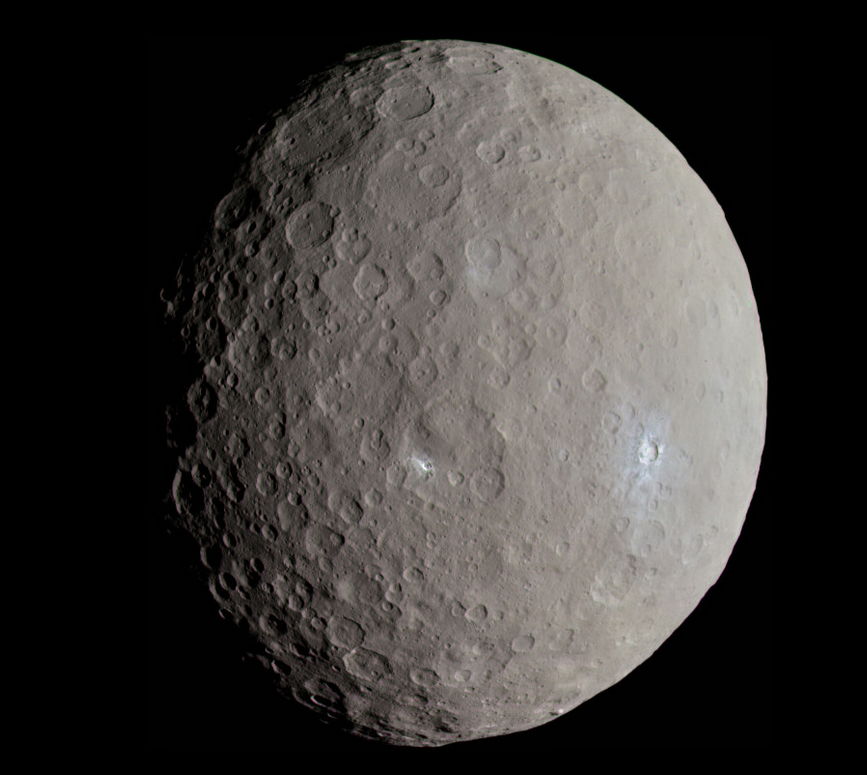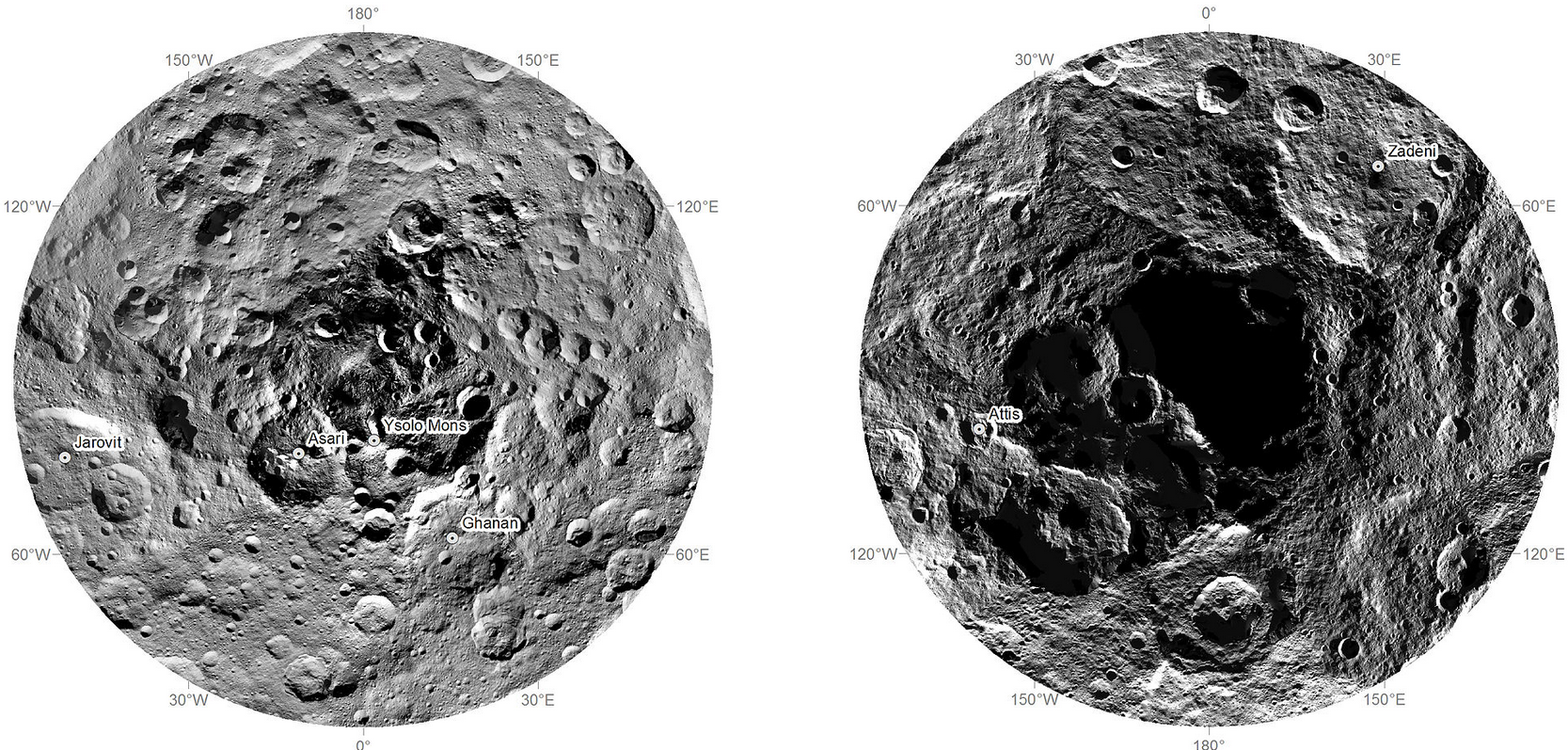What Is Ceres?
Ceres is a dwarf planet found in the extensive asteroid belt that sits between Mars and Jupiter. It is a small dwarf planet that usually can not be seen with the naked eye from Earth unless the skies are especially dark.

Although its presence has been known for over a century little was really known about it until 2015. It is the largest object within the asteroid belt and the only dwarf planet to be found within the inner solar system.
Ceres’s Structure
Named for the Roman goddess of corn and harvests Ceres was likely formed 4.5 billion years ago when gravity pulled swirling gas and dust together to become this small dwarf planet. It is often referred to as an embryonic planet because it started to form but did not quite reach completion.
The reason it did not fully form is thought to be the gravitational effects of nearby Jupiter, a massive gas giant planet. Ceres likely settled into its current orbit among the asteroid belts leftover pieces about 4 billion years ago.
As a dwarf planet its structure is similar to that of the first 4 planets of our solar system Mercury, Venus, Earth and Mars. It is however not as dense although it does have layers like the four terrestrial planets. These layers are less clearly defined but it likely has a core and a mantle.
It is likely the planet is made up of roughly 25% water which means it would actually have more than Earth. The crust is most likely rocky and dusty with sizable salt deposits. This isn’t your average table salt however as there may be several types of salt based on different minerals for example magnesium sulfate.
Surface
Despite the fact Ceres must have been peppered by countless asteroids over the last 4 billion years, its surface craters are relatively small although numerous. It is likely that the effects of ice and low density surface materials such as salts may have smoothed Ceres somewhat. Ice volcanoes may also have covered large craters that once existed on Ceres’s surface.

Atmosphere
There is a very thin atmosphere on Ceres which seems to have water vapor. This has likely come from either ice volcanoes or surface ice sublimating. The nature of Ceres and its atmosphere has scientists interested in searching for signs of basic life. Unlike other planets of the solar system Ceres like Earth has surface water.
Does Ceres Have Moons?
Ceres does not have any moons orbiting it although it orbits alongside hundreds of asteroids within the belt. It also has no rings. It seems unlikely that moons or rings are in Ceres’s future.
History of the Observation of Ceres
Although technically visible with the naked eye from earth in perfect conditions the astronomers of antiquity had no knowledge of Ceres’s existence. As early as 1596 theoretical astronomer Johannes Kepler thought there may be another planet between Jupiter and Mars. This is due to evident gravitational effects on the two planets.
Essentially astronomers felt like another planet may be there somewhere but they could not locate it. In 1800, Franz Xaver von Zach, editor of the German astronomical journal Monatliche Correspondenz headed a group which sent requests to 24 experienced astronomers. These astronomers were dubbed the “celestial police,” and were asked to combine their efforts in the search for this potential planet. This resulted in the discovery of the asteroids Pallas, Vesta and Juno.
Among these 24 astronomers was Catholic priest Giuseppe Piazzi who attended the Academy of Sicily. On January 1st 1801 before being invited to the group Piazzi actually found Ceres. Searching for a specific star, Piazzi actually located a moving star-like object which he assumed to be a comet. He would view it 24 times between January 1st and February 11th 1801.

Ceres was lost track of briefly as Piazzi had to take a break due to illness and by the time his findings were reported to other astronomers it had moved too close to the Sun to be visible. It eventually moved away but not enough was known of its orbit to predict where it would next be seen.
It took mathematician Carl Friedrich Gauss to develop an efficient method of orbit determination. It would take him a few weeks of work but he was able to predict where Ceres should be in the night sky. It was late December of 1801 that Ceres was relocated.
Initially thought to be a comet it quickly became assumed to be the missing planet but ultimately would be classified as a Dwarf Planet.
Space Exploration
The Dawn spacecraft was the first space to pass close to Ceres. It was launched on September 27th 2007 intending to make its first stop Vesta. On May 3rd 2011, the Dawn acquired its first images of Vesta and would proceed to orbit it for thirteen months. The Dawn then used its ion engine to depart for Ceres, being captured into the dwarf planet’s gravity on March 6th 2015.
There are talks of mounting future missions to try and find out more about Ceres and may even include attempts to gather mineral samples from the surface. China currently seems the most likely to embark on a future mission of exploration to Ceres.
How Far Is Ceres from Earth?
The smallest but closest to Earth of all dwarf planets Ceres is far closer than the likes of Pluto and Eris. Situated between Earth’s neighbor Mars and Jupiter its distance from us varies based on the positions in our respective orbits.
Sometimes Earth and Ceres are closer to each other than to others. When at their closest Earth is roughly 146,309,842 miles away from Ceres. The two have not been that close since February 11th 1636.
Final Thoughts
The closest Ceres has ever been to Earth was in the Winter of 1636 when it passed within just over 146 million miles of the planet. This is the closest dwarf planet to Earth and is essentially a protoplanet in that it never fully formed into a full planet. Had it done it may have several common factors with our own planet and even as it stands scientists are interested to discover if basic life may now or in the past have thrived on its surface.
